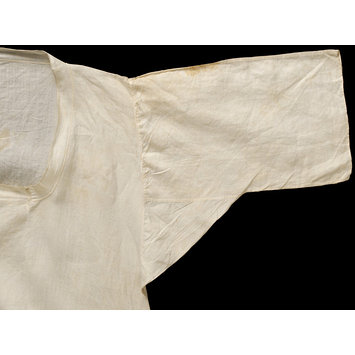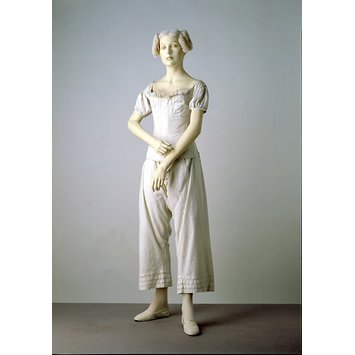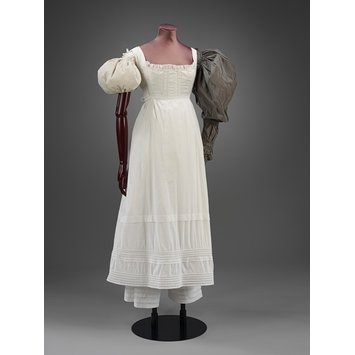This post is about my plans for making/buying Regency era underthings for my 2021 Regency Project.
The Layers
There are three main undergarment layers in the Regency period. I own nothing suitable at present, so I will need to buy/make everything here.
1. A shift - This will be a basic, square necked garment. The purpose of this garment is to protect my outer garments from me, as in my sweat etc. The shift is easier to change and to wash, so was very important for keeping outer garments less smelly or dirty. They didn't wick everything away, but less sweat on your fine dress is still better. In the Regency era there seems to have been some variation on whether your shift had sleeves depending on what you were wearing. When worn with a long sleeve dress, it could have had short sleeves like the V&A example below, but with the very short sleeves, it may have just had a slim shoulder strap. Unlike a medieval shift (the ones I have currently!), a Regency shift has a much more open and square neckline to fit under the dress necklines of the era. Although women were still rarely showing actual cleavage at this point, the area between the neck and breastbone was more likely to be partially or completely uncovered in comparison with earlier eras. That necessitated the change in necklines.
1a. Long drawers or pantalettes. In the later Regency era, this layer sometimes also included leg coverings (see the below the stays in the next image). These could even be visible below the skirts for some women. These were two single legs gathered to a band as clothing approaching modern knickers wasn't worn by "nice" women at this point.
2. Long stays (image from the same page as the V&A shift above). Along with the change in necklines and shift patterns, this era also saw a change in undergarments. Others have done far more research than I on the changes of support garment during this era, but in summary, the main changes were a distinct "cup" area which caused/was caused by a change in how the breast tissue was shaped and supported. Prior to the introduction of the Regency silhouette, women's breast area was supported by being bound against the body, usually either with a specific boned undergarment or via the cut of their underdress or kirtle. The flimsiness of early Regency dresses seems to have triggered a need for a new type of support, which went through various iterations. In the c1818 period I am looking at, this would have been long stays. Long stays could be boned or corded, and gently contoured the body from armpit to around the hips, and seem to have included dome kind of breast cupping or pocket.
Regarding the stays I will make or buy, I read this rather interesting study, which seems to suggest that by the time I'm looking at, cording was beginning to be dominant over boning as the method of support. Depending on patterns and cost of materials, I will seriously consider whether "Harriet" would have worn an older set of stays that from 10+ years earlier, or whether she might have updated to the newest style...
3. A petticoat which goes over the stays and protects the dress while creating an appropriate shape. Like the shift, the petticoat had been forced to change shape from earlier eras. Some Regency petticoats were hung on thin straps from a high underbust waistband, and others were entirely without straps. I am practically minded, so thin straps seem logical to reduce the risk of it slipping!
The image below also includes artificial arm puffs to boost the shape and stability of early Regency sleeves. That's not in my plan so I won't need them at least!
I'll skip (making) other underwear and wear normal tights instead of stockings.
To do list for an underwear layer:
- Buy a basic suitable shift from a vendor, possibly at the next TORM that runs
- Make a set of long stays. Long ones because I'm "squishy", and need more control to achieve that silhouette.
- Buy a kit and pattern -
- I'm looking at getting this RedThreaded kit if the postage isn't too punitive and I choose the boned variant
- If I go for corded, then maybe the Laughing Moon pattern #115 . This pattern also includes instructions for a simple chemise. I found an online class that follows the LM pattern as well. These instructions may help if I go it alone.
- Buy fabric.
This layer will be next to my skin, so it needs to be breathable. Going by museum pieces and the Foundations Revealed article (linked above), I will probably buy cotton instead of linen, as cotton seems to be beginning to dominate for underwear by the later Regency period.
A middle class lady may well have had contacts with the owners of the burgeoning local cotton mills by blood, marriage, or friendship, so wearing cotton would have been a practical choice.



